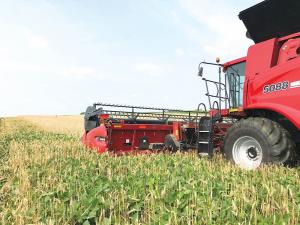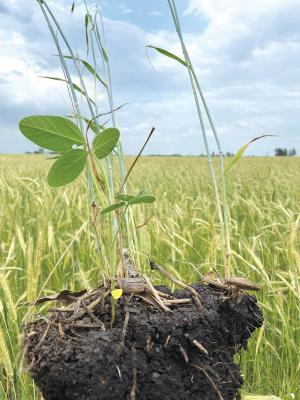2023 - Volume #47, Issue #4, Page #02
[ Sample Stories From This Issue | List of All Stories In This Issue | Print this story
| Read this issue]
Relay Cropping Boosts Bottom Line
 |
 |
“A lot of our cover crops are harvested, not terminated,” says Hora. “Cereal rye is ideal due to its height difference over soybeans when it’s harvested.”
Hora and his father Brian have been doing relay cropping for about 5 years. They started with a 10-acre plot and are now at 150 acres of their 350-acre soybean fields. Cereal rye is solid seeded in the fall at a 55 to 60-lb. rate with 7 1/2-in. row spacing at a slight negative angle to the corn stubble. In the spring, he decides whether to terminate it or harvest it.
Soybeans are solid-seeded at the same 7 1/2-in. spacing the second week of April when the rye is only 4 to 6 in. tall. It’s drilled into the rye at a slightly positive angle. The combination of off (corn) row planting helps break down the stubble.
“At that point, the rye is still short enough that the emerging soybeans aren’t shaded out,” says Hora.
As with any cover crop, the previous year’s nutrients are carried forward. Hora reports 120 credits following cereal rye. This benefits the growing soybeans in two ways. Because the N is sequestered in the rye, the soybeans have to work harder to produce the N they need.
“The soybeans nodulate more, and then the harvested rye releases sequestered nutrients in August and September when the soybeans need it the most,” says Hora.
As a result, after taking a 30-bu. per acre rye harvest, he later harvests 70-bu. soybeans. “The rye crop also reduces our need for fertilizer and pesticides,” says Hora.
“We harvest the rye in mid-July when it’s about 4 ft. tall,” says Hora. “We have to manually control the header, as there’s only about 15 in. clearance over the soybeans. We follow harvest with a single herbicide pass of Roundup to clean up the field.”
Initially, crop insurance was an issue when trying relay planting. “You have to have conversations with crop input providers, crop insurance providers, and your banker,” says Hora. “Everyone has to be on the same page, but we’ve been able to prove it works much better than a conventional single crop system.”
The proof comes in the increased income from the sale of rye seed at $15/bu. off the farm. At 30 bu. per acre, it adds $450 per acre income while reducing soybean inputs. While it may limit potential soybean yields, that’s not a problem for the Horas.
“Growing 100-bu. soybean yields is not something we want to pursue on our farm,” he says.
Combined with long-term no-tilling and heavy use of cover crops, reducing inputs is adding more to the bottom line. Hora credits improved nutrient cycling and availability, as well as increased biological activity. Organic matter has increased by 1.2 percent over 10 years.
“We can infiltrate 4 in. of rain in 6 seconds,” says Hora. “The national average is 1/2-in. per hour.”
Off-farm input reduction is also paying off. The Horas have reduced nitrogen applications from 230 units to about 155, with a whole farm average yield of 245 bu. Pesticide applications have been reduced by 75 percent.
“Phosphorus has been cut to 50 lbs. every other year from 250 lbs. every year,” says Hora. “We completely eliminated potassium applications aside from a little potassium sulfate. We have reduced MAP from 250 lbs. every year to 50 ahead of corn and have done zero lime for the past 11 years.”
Carbon credits are another way the no-till, cover crops, and relay cropping will pay off. “The national average for carbon intensity is 29.1 per acre,” says Hora. “Our score is a negative 4.4. This will be extremely important for low carbon markets and is a huge opportunity.”
Hora continues to farm with his father, exploring and intensifying their regenerative farming practices. At the same time, he heads up Continuum Ag, a soil health data intelligence firm, for others wishing to improve their soil health.
Contact: FARM SHOW Followup, Mitchell Hora, Continuum Ag, 108 W. Main St., Washington, Iowa 52353 (ph 319-461-9056; info@continuum.ag; www.continuum.ag).

Click here to download page story appeared in.

Click here to read entire issue
To read the rest of this story, download this issue below or click here to register with your account number.




